English - PRAVASI BHARATIYA - Overseas Indian
English - PRAVASI BHARATIYA - Overseas Indian
English - PRAVASI BHARATIYA - Overseas Indian
Create successful ePaper yourself
Turn your PDF publications into a flip-book with our unique Google optimized e-Paper software.
NEWSENERGY SECURITYBlocks of ASSETSIndia is drafting a new regime to auction hydrocarbon reservesSedimentaryBasinsIndia is working on a new policyto auction hydrocarbonassets for exploring oil and gasreserves on a perpetual basis,with a database being drawn up ofall the country’s potential reserves,Petroleum Secretary S. Sundareshanhas said. “The Directorate Generalof Hydrocarbons is working on whatis called a national data repository— a database of our potential oil andgas assets. This should be ready inthe next four-five months,” he said.“Then we will have a new policy,an open acreage system. Oil and gasblocks will then be on offer throughA BIT OF HISTORYIn 1866, the first well in India wasdrilled by Mr. Goodenough ofMcKillop, Stewart and Co, followingclue of oil detected in the feetof an elephant carrying logs.In 1889, Digboi well No. 1 wasstarted by W.L. Lake of AssamRailways and Trading Co. Lakeurged his boys “Dig boy, dig”,giving birth to Digboi.The <strong>Indian</strong> economy is a netimporter of almost all forms ofenergy. This fact, coupled withIndia’s growing energy needs, hasintensified discussions on energysecurity for the country. The governmentis actively seeking private participationin the energy chain and isalso promoting acquisition of oil andgas reserves overseas. Strong privatethe year and not based on rounds.But I’m not assigning a time frame,”Sundareshan told IANS in his firstsubstantive interview since he tookcharge on February 1.“The next round of bids may bethe last under the existing licensingpolicy,” he said, referring to theupcoming ninth round of auctionsunder what is called the new explorationlicencing policy.In the existing regime only a limitednumber of oil and gas blocksare identified and offered for thedomestic and global companies tobid. In the proposed new regime,called the open acreage licencingsystem, a database of all such blockswill be made available in the publicdomain and a company canapproach and bid for a particularblock anytime during the year.“The choice of selecting a block forauction will be with the investor —and not with the government,” hesaid. “We will sign the agreementsfor these blocks shortly.”Sundareshan said he would hopeto “resolve once and for all” theissue over pricing of transport andcooking fuels for oil marketing companies.The oil ministry will alsocome out with a policy on availabilityand pricing of natural gas notonly from the Krishna-GodavariKEY PLAYERSsector participation is required tosupplement the public sector andbring in the required investments andtechnologies. Policies have increasinglyrecognised the need to promoteprivate investment. Private interest inoil and gas exploration and in powersector has increased significantly. Atthe same time, both the governmentand private sector companies arelooking to acquire equity in energyassets abroad. (Source: DirectorateGeneral of Hydrocarbons)Self sufficiencyin oil and gasis something no onein this ministry, atleast, can ignore.This will be animportant goal. Adifficult goal, but wemust work towardsthis. There is nochoiceS. Sundareshanbasin, but also future discoveries.“Self sufficiency in oil and gas issomething no one in this ministry,at least, can ignore. This will be animportant goal. A difficult goal butwe must work towards this. There isno choice,” he said.— Arvind Padmanabhan &Murali KrishnanTHE NEW SYSTEMIn the existing regime — whereeight rounds of auctions havetaken place so far — only a limitednumber of oil and gas blocks areidentified and offered for thedomestic and global companies tobid.In the proposed new regime,called the open acreage licensingsystem, a database of all suchblocks will be made available in thepublic domain and a company canapproach and bid for a particularblock anytime during the year.The sedimentary basins of India,onland and offshore up to the 200misobath, have an aerial extent ofabout 1.79 million sq. km. So far, 26basins have been recognised and they havebeen divided into four categories based ontheir degree of prospectivity as presentlyknown. In the deep waters beyond the 200misobath, the sedimentary area has been estimatedto be about 1.35 million sq. km. Thetotal thus works out to 3.14 million sq. km.Over the past 12 years, the unexplored areahas come down to 15 percent which was 50percent in 1995-96. Credit for this goes inlarge measure to the surveys carried out bythe Directorate General of Hydrocarbons(DGH) established by the government ofIndia in 1993. The DGH has been entrustedwith several responsibilities like implementationof the New Exploraton Licencing Policy,matters concerning Production SharingContracts for discovered fields andexploration blocks, promotion of investmentin the Exploration and Production (E&P)sector and monitoring of E&P activities.EyeingChinaThe <strong>Indian</strong> governmenthasapproved the participationof ONGCVidesh Ltd (OVL) and GAIL in theconstruction of a Chinese pipelineand also make additional investmentof over $1.3 billion in thedevelopment of Myanmaresehydrocarbon blocks.The Cabinet Committee on EconomicAffairs on February 18approved OVL’s investing $167.84million in a pipeline being constructedby China NationalPetroleum Corp to transport gasfrom offshore A-1 and A-3 blocks inMyanmar. GAIL has been approvedinvestment of $83.88 million in theChinese pipeline, allowing OVL andGAIL to take 8.35 and 4.17 percentparticipating interest in the pipelineto transport gas from Myanmar’sA-1 and A-3 offshore blocks.Hydrocarbon assets: These mainlyconsist of oil and gas reserves. Oiland gas blocks are identified andoffered to companies for bidding.Discovery: It means the finding,during petroleum operations, of adeposit of petroleum not previouslyknown to have existed, which can berecovered at the surface in a flowmeasurable by petroleum industrytesting methods.Barrel: A quantity or unit equal to158.9074 litres (42 United States gallons)liquid measure, at a temperatureof 60 degrees Fahrenheit (15.56degrees Celsius) and under oneatmospheric pressure (14.70 psia)Contract Area: Contract Areameans, on the Effective Date, thearea described in Model ProductionSharing Contract and delineated onthe map attached or any portion ofthe said area remaining after relinquishmentor surrender from time(Source: Directorate General of Hydrocarbons)A quick primerto time pursuant to the terms of thisContract.Crude Oil: ‘Crude Oil’ or ‘Oil’ or‘Crude’ means all kinds of hydrocarbonsand bitumen, both in solidand liquid form, in their naturalstate or obtained from Natural Gasby condensation or extraction, butexcluding Natural Gas.Gas Field: Means, within the ContractArea, a Natural Gas Reservoiror a group of Natural Gas Reservoirswithin a common geologicalstructure or feature.Oil Field: Means, within the ContractArea, an oil reservoir or agroup of oil reservoirs within a commongeological structure or feature.Commercial Production: The productionof Crude Oil or Condensateor Natural Gas or any combinationof these from the Contract Area andtheir delivery at the Delivery Pointfor regular production and sale.10 Pravasi Bharatiya March 2010 Pravasi Bharatiya March 2010 11


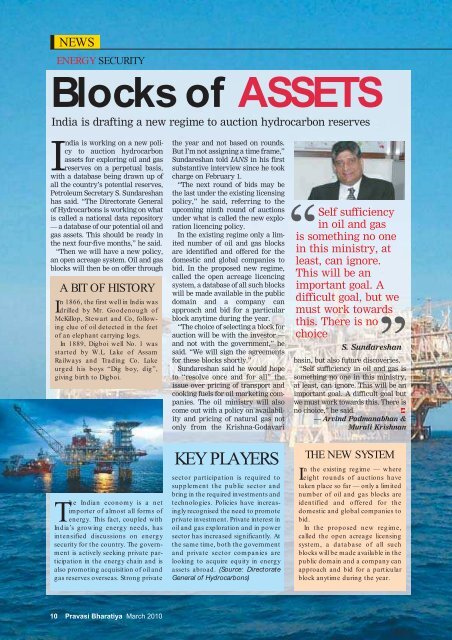
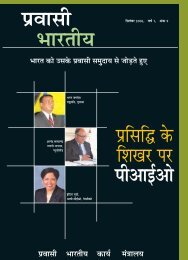



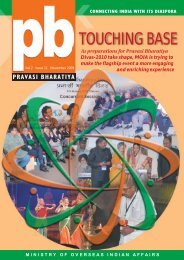
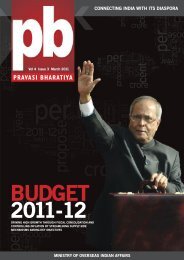

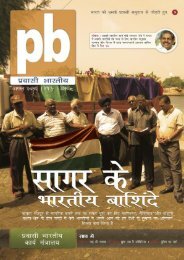
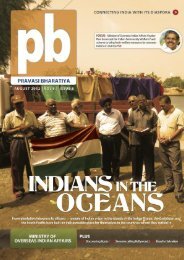
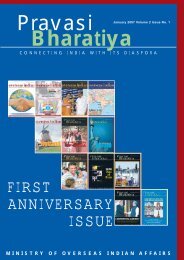


![flaxkiqj feuh izoklh Hkkjrh; fnol] vDVwcj 9&11 - Overseas Indian](https://img.yumpu.com/43977040/1/184x260/flaxkiqj-feuh-izoklh-hkkjrh-fnol-vdvwcj-911-overseas-indian.jpg?quality=85)
